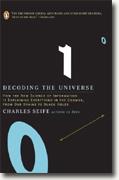Decoding the Universe
Charles Seife
book reviews:
· general fiction
· chick lit/romance
· sci-fi/fantasy
· graphic novels
· nonfiction
· audio books
· author interviews
· children's books @
curledupkids.com
· DVD reviews @
curledupdvd.com
newsletter
win books
buy online
links
home
for authors
& publishers
for reviewers

 |
Decoding the Universe: How the New Science of Information Is Explaining Everything in the Cosmos, from Our Brains to Black Holes Charles Seife Penguin Paperback 304 pages January 2007 |
|
The farther one looks down into the finite details of the ever-increasing depths of computer science and information, into the cybernetic arterioles of the PC and the Mac, the farther one sees out into the universe.
Decoding the Universe For me, this book is a good review of quantum mechanics, black holes, multiple universes, paradoxes, dimensionality, and additional concepts. In addition, Seife concludes that Information Theory accepts bits of information as physical entities. Perhaps there are information electrons! This is where many brains twist up. Information comprises concrete matter and energy that can be measured. Information has weight. It has mass and energy. This is easy to believe, since each new bit of information learned forges another wrinkle in the brain. Transmitting information also consumes energy. I know this to be true, because during the four hours of the ACT examination I took in one sitting, I lost four pounds. I also know that when my computer disk is full of information, I canít get anything else onto it. Further, conducting materials such as copper wires, fiber optic cables, and computer paper all are limited in the number of bits they can transmit. Info takes up space! Information bits for the computer are expressed as either 0 or 1. Seife also explains DNA sequences as series of 0ís and 1ís (no charges and charges, off and on), and that makes perfect sense to me. Iíve long thought that there may be one long strand of DNA coiled up in everything organic, with only certain switches turned on (charged) in order to create a particular species. That is far-fetched, but similar to Seifeís thinking. Even more interesting is Seifeís illustration that mathematical formulas for the expansion of gases (following fractal patterns, actually) are exactly like equations for the transmission of information. Fractals, fractals, everywhere and every bit is real. Letís consider the Big Bang. When the Bang occurred (or God lit a giant match), it threw out information bits that spread via explosive expansion in fractal pattern(s). When it is finished expanding and all of the bits of info are evenly distributed throughout forever-ness, the universe will be dark and empty and the light of Genesis will no longer ďbeĒ. This is entropy -- until the next match strikes. Seife also includes an interesting history of early information theory that was developed by the cryptographers of World War II. These math whizzes reduced information to its basic components in order to code the un-crackable code. Of course, they eventually needed help from the Navajo nation for complete success. The Navajo were more in tune with the abstract (and, perhaps, the universe) and made the only codes that no one on earth could crack. This book has encouraged me to explore the topic of information further. I recommend it to anyone interested in science, science fiction, and exploring the lesser known. Originally published on Curled Up With A Good Book at www.curledup.com. © Patty Inglish, MS, 2007 |
|
|
|
 Click here to learn more about this month's sponsor! |
|
| fiction · sf/f · comic books · nonfiction · audio newsletter · free book contest · buy books online review index · links · · authors & publishers reviewers |
|
| site by ELBO Computing Resources, Inc. | |
 That has been my belief since the first time I saw a film of UNIVAC computer. Now Charles Seife has written
That has been my belief since the first time I saw a film of UNIVAC computer. Now Charles Seife has written